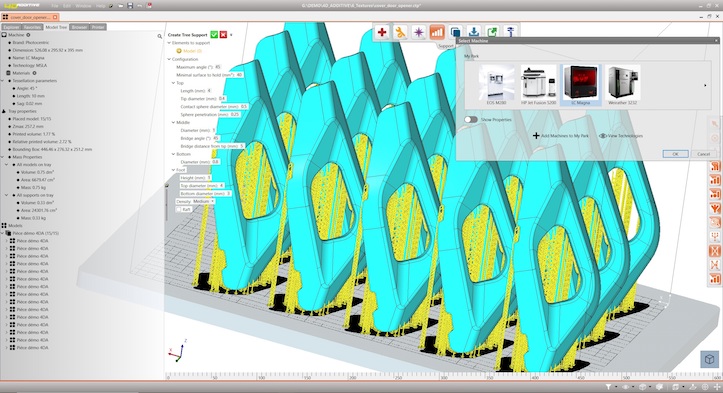 The software manufacturer CoreTechnologie is presenting a revised version of its innovative 3D printing software 4D_Additive at the Formnext 2021 trade fair. The focus here is on direct connection to 3D printers and the generation of surface textures and grid structures.
The software manufacturer CoreTechnologie is presenting a revised version of its innovative 3D printing software 4D_Additive at the Formnext 2021 trade fair. The focus here is on direct connection to 3D printers and the generation of surface textures and grid structures.
German-French software specialist CoreTechnologie has further developed its renowned 3D printing software 4D_Additive and will present the latest version at the Formnext trade fair in Frankfurt from 16 to 19 November 2021.
With one software from CAD system to 3D printer
By integrating the interfaces of EOS, Photocentric, HP and Volumic into the new 4D_Additive software version, data handling is made easier. Models of all common CAD formats as well as triangulated STL data can be read in, prepared for printing and sent directly to the printer. A unique feature is the direct processing of exact CAD data, allowing 3D models to be processed as in the CAD system. The software suite eliminates the costly and time-consuming use of various tools. The 4D_Additive 1.4 version, which will be presented for the first time at the Formnext 2021 trade fair, allows print jobs to be sent directly from the software to current EOS machines by integrating the Eosprint software development kit (SDK).
New component designs and generation of DMC codes
The revised Lattice module of the 4D_Additive software enables the creation of complex 3D lattice structures within seconds. Using gyroid patterns and trabecular structures to emulate natural lattices, new types of designs are generated to optimise the stability, stress distribution and shock absorption of components. The variation of the functional zones and their density as well as the use of different grid types allows the exact adaptation of the geometry to required properties.
With the new 4D_Additive software, high-resolution textures and labels are generated on CAD models as well as on STL data. In addition, the new tool includes functions for generating DMC codes that can be read with a special scanner. The module's Substance database allows access to over 5,000 predefined surface designs. Users can also create their own individual designs.
Nesting with artificial intelligence
The revised nesting module of the new 4D_Additive version uses adaptive voxel technology and artificial intelligence to ensure optimum utilisation of the installation space and even distribution of components to avoid heat nests. The new Powercopy function allows the contour-oriented multiplication of components in all axes. High calculation speed is achieved through multiprocessor technology.
Slicing and Supports
For the requirements of SLA and FDM, the new software has support geometries as well as special FDM hatching strategies and a G-code generator. The display of the individual layers is possible with a high-resolution 3D player. The support structures are automatically generated as B-Rep, i.e. as editable CAD geometry for individual modification and adaptation by the user.
CoreTechnologie will present the new 4D_Additive version live at the Formnext trade fair in Frankfurt from 16 to 19 November 2021 in Hall 12.0 at Stand E 69.
www.coretechnologie.de